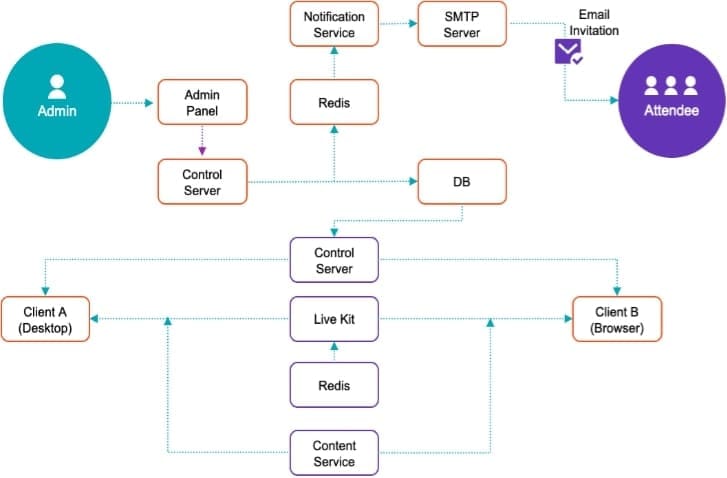The increasing complexity of IT infrastructures has made secure, efficient, and scalable desktop support a critical need for organisations. Traditional remote support tools often fall short in environments requiring high-security measures and on-premise deployments, such as critical infrastructure, government agencies, and defense operations.
Huddle emerges as a robust solution tailored for these demanding scenarios, leveraging cutting-edge technologies like Kubernetes and microservices to provide unparalleled stability, scalability, and security.
Understanding Huddle’s Architecture
At its core, Huddle is built on a Kubernetes-based microservices architecture. This design ensures modularity, high availability, and fault tolerance. By deploying microservices in isolated containers, Huddle achieves greater flexibility and simplified maintenance compared to monolithic architectures. Kubernetes orchestrates these containers, enabling dynamic scaling to handle varying workloads and ensuring seamless recovery from node failures.

Backend Technology
Huddle’s backend is composed of:
- Kubernetes Orchestration: Facilitates container deployment, scaling, and management. Kubernetes’ inherent load balancing and service discovery capabilities enhance Huddle’s performance under heavy usage.
- Microservices Framework: Divides functionalities into independent services, such as authentication, file sharing, and screen sharing. Each service can be updated or scaled without affecting the entire system.
- Database Layer: Utilises a high-performance database cluster for rapid data retrieval and secure storage. Advanced encryption protocols ensure data integrity and compliance.
- Security Protocols: Implements Zero Trust principles, with multi-layer authentication and role-based access control (RBAC), and configurable UAC-based access to prevent unauthorised access.
Feature Breakdown
Huddle offers a suite of features tailored to technical and security-intensive environments. Here’s a technical breakdown:
- Screen Sharing: Huddle’s screen-sharing functionality operates over encrypted channels, minimising latency and ensuring data security. Compression algorithms optimise bandwidth usage for seamless performance.
- File Sharing: Leveraging secure file transfer protocols (SFTP), Huddle ensures end-to-end encryption during file transmission. Files are stored temporarily in encrypted containers to avoid persistent storage vulnerabilities.
- Audio-Video Conferencing: Powered by WebRTC technology, Huddle supports high-quality, low-latency audio-video communication. Built-in NAT traversal ensures connectivity across firewalls.
- Screen Recording: Utilises a lightweight recording engine to capture sessions with minimal impact on system performance. Recordings are stored in secure, tamper-proof formats for compliance purposes.
- Chat Functionality: Real-time messaging is achieved using a publish-subscribe messaging model, ensuring instant communication and delivery confirmation.
- Remote Troubleshooting: Grants authorised IT staff secure remote access to diagnose and fix issues.
- One-to-One and Group Sessions: Supports individual troubleshooting or collaborative meetings depending on the use case.
Comparing Huddle with Competitors
Unlike traditional desktop support tools that rely on cloud-based infrastructures, Huddle’s on-premise deployment eliminates dependency on third-party servers. Competitor tools often lack the granular control and compliance capabilities Huddle offers, such as:
- Data Residency: Huddle ensures all data remains within the organisation’s infrastructure.
- Scalability: Kubernetes-based scaling surpasses fixed-resource cloud solutions.
- Customisation: Microservices architecture allows bespoke configurations tailored to organisational needs.
Feature | Huddle | TeamViewer | AnyDesk |
Deployment Model | On-Prem with Kubernetes | Cloud-Only | Hybrid |
Security Protocols | Zero Trust, RBAC, Encrypted Data | Limited Encryption | Partial RBAC |
Scalability | Kubernetes-Driven | Static Resources | Limited Auto-Scaling |
Operational Framework
Huddle delivers stable, high-performance operation across varied deployment scales. For real-time troubleshooting, recommended concurrent user count is up to 10 participants, while collaborative meetings can accommodate up to 50 users without impacting performance.
All interactions are protected with TLS encryption, multi-factor authentication, and role-based access control, ensuring secure user verification and restricted access. Comprehensive audit logs maintain full visibility and compliance.
By combining controlled scalability with strong access governance, Huddle provides a secure, consistent, and high-performing experience for both IT support and collaborative use cases.
Conclusion
Accops Huddle redefines on-premise desktop support with a technical foundation rooted in modern, scalable, and secure architecture. By addressing the operational and compliance challenges of high-security environments, it delivers a solution that IT professionals can trust and decision-makers can confidently deploy—ensuring every remote session remains secure, compliant, and under complete organisational control.

